|
FAQs about Faviid Coral Environmental Disease
FAQs on Faviid Disease:
Faviid
Disease 1, Faviid Disease
2, Faviid Disease 3,
Faviid Disease 4, Faviid Disease 5, Faviid Disease,
FAQs on Faviid Disease by Category:
Diagnosing,
Nutritional, Social (Allelopathy),
Trauma,
Pathogenic (Infectious, Parasitic, Viral)
Predatory/Pest, Treatments
Related Articles:
Coral Pests and Disease; pests, predators, diseases and conditions by Sara
Mavinkurve,
Faviid
Corals,
FAQs on Stony Coral Disease: Stony Coral Disease 1, Stony Coral Disease 2, Stony Coral Disease 3, Stony Coral Disease 4, Stony Coral Disease 5, Stony Coral Disease 6, Stony Coral Disease 7, Stony Coral Disease 8, Stony Coral Disease 9, Stony Coral Disease 10, Stony Coral Disease 11, Stony Coral Disease
12, Stony Coral Disease 13,
Stony Coral Disease 14,
Stony Coral Disease 15, Stony Coral
Disease ,
FAQs on Stony Coral Disease by Category: Diagnosing:
Environmental (Pollution/Poisoning, Lighting...),
Nutritional, Social (Allelopathy),
Trauma,
Pathogenic (Infectious, Parasitic, Viral)
Predatory/Pest,
Treatments
FAQs on Stony Coral Disease by Type: Brown Jelly Disease, RTN,
|
|
|
Declining Caulastrea 5/4/10
Dear Bob and Crew,
<Howsit Joe?>
Again, the highest praise for your talents and time! WWM is a
blessing to all. Special thanks for the daily photos- they are
always surprisingly beautiful.
<Thank you>
I do hope this message is not too long. I felt it important to
include all relevant information.
<Please always do>
I'm in the middle of revamping my 54 gallon corner reef tank
after an outbreak of Ich. Luckily I only lost two fish and the
system has been fallow since 3-1-10. Only 3 corals exist as of
now here: 2 Euphyllias and
one Candy Cane, the latter which is partially receding (see pic).
The system utilizes a skimmer, 150 watt 14,000K HQI, 20 watt NO
actinic and is relatively low flow with about 700 gph turnover
rate from return, rotating powerhead, and HOT skimmer. I
downgraded this amount as I noticed better expansion from the
Euphyllias from lower flow. Today's water parameters are as
follows:
SG- 1.024 (normally kept at 1.025)
<I would keep this higher... check your hydrometer (if this is
what you're using to measure Spg) with a hydrometer>
Temperature- 78 degrees F
pH- 8.2 (a.m. reading)
DKH- 7
Ammonia- 0
Nitrite- 0
Nitrate- 0 (though present in tank)
<Good... your corals do need some>
Calcium- 350 (raising gradually with B-Ionic)
No magnesium test kit as of yet
<I would get, use>
The system uses Tropic Marin salt, Culligan RO water, and I have
not used any additives minus the B-Ionic as well as pre-buffer
for the RO water. I use Purigen in the sump. Specimens (not
including corals) include 2 Turbo snails, 3 Margarita snails, and
4 tiny hermit crabs.
The specimen is placed about 18 inches below the HQI bulb. My
best guess would be a lighting or water flow issue. I would guess
that the low calcium would not be the cause. I would also
discount allelopathy due to the few and like species involved. I
have not witnessed any hidden predation either. Any suggestions
would be highly valued.
Lastly, thank you so much for the new edition of "The
Conscientious Marine Aquarist"! My old copy was totally
destroyed from years of use and the new edition is a true
blessing!
Thanks!
Joe W.
<Mmm, let's see... I would move this colony up a bit
higher, on the rock, towards the light here... Please peruse
here:
http://wetwebmedia.com/faviidsysfaqs.htm
and the linked files above. Bob Fenner>
|
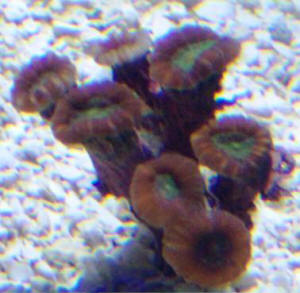 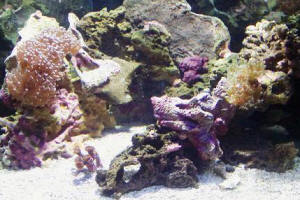 |
|
Sick coral - 2/10/10
Hi helpful and kind folks at WWM.
<Hello most wonderful and interesting Querior!>
I need your help with my favourite coral. <Ok>. I bought
this Favites from my LFS about 2 weeks ago (see picture labeled
1-29-10). Initially I had it at the bottom of my 6 gallon Nano
(36 watt PC lights) and it was doing well, so I moved it up about
4 inches to about the middle of the tank and glued it to a live
rock. A few days after that it was eating well during the day,
and extending some wonderful tentacles. Last few days it puts out
small tentacles at night only and refuses to eat when I try to
spot feed it Mysis (or anything else).
<Mmmm, they do feed mostly at night in the wild, I would not
be concerned re: this yet>
Most concerning is the discolored spot I noticed today (see other
pix) -- (? tissue recession)?
<No, I don't think so - maybe a small expulsion of some
Zooxanthellae, a reaction to being moved 'upwards'. Could
be an expansion of the coral itself. I would not be concerned too
much. Keep an eye out and see what happens, but this coral looks
ok to me. Monitor for a while, when it settles into it's new
spot it should be ok, these are not particularly difficult
corals>
Any help at all would be appreciated.
<You have my opinion, Nick. One thing I would say is that 6
gallons really is 'Nano' and if there is a problem with
the coral it is likely due to some part of your system being
unstable, as it is notoriously difficult to keep things 'on
an even keel' in such a small water volume, especially
temperature>
Nick N
|
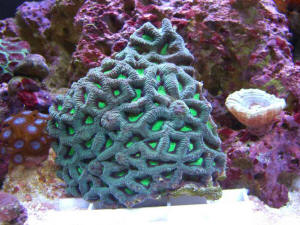 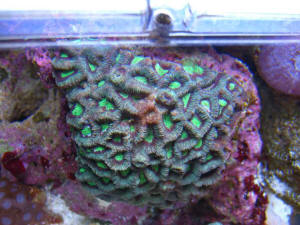
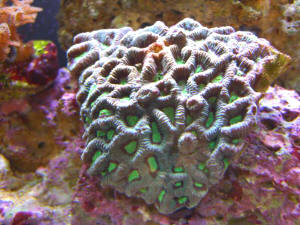 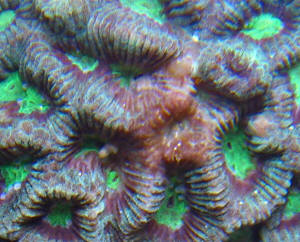 |
Re: 10/02/10 Sick coral
Thanks for your reply, Simon.
<No problem Nick>
As you can see from the attached picture, the discoloured area has
expanded from yesterday and (this may be hard to see in the
picture) the mouths in the affected area are becoming partly
black.
<Mmm, that does not sound good...did the onset of this problem
coincide with any change that you have made to the system, or in
the room where the system is housed?>
Any other ideas?
<Other than try to maintain some 'stable' parameters,
what other Cnidarian life do you have in here? Allelopathy could be
a cause, try here: http://www.wetwebmedia.com/cnidcompppt.htm. As
mentioned, in such a small system you will have problems with
creatures such as this. I would be running some carbon>
Anything else I should do? An iodine-based coral dip?
<Could, yes, this coral should stand up well to an iodine dip,
but I suspect that there is something in/ about your system that is
the root cause here. Simon> |
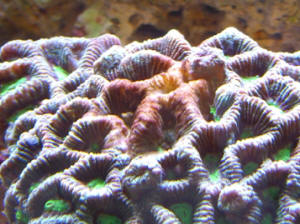
|
Re: 10/02/10 Sick coral
2/11/10
I'm very sad. The brown tissue was dead tissue.
<I would in that case dip this coral w/ Iodine
pronto>
I blew on the coral with a turkey baster and the brown
flesh flew off in chunks (surprising how much soft tissue
covers those hard skeletons).
<No! don't let this settle on any of your other
corals...if you must do this in tank it is better to suck
off with the baster and not blow>
I will probably frag whatever is still alive tomorrow.
<Mmm, be careful here... if you can stop the recession
w/ a dip then I would not frag this yet>
What a shame...
<Yes, indeed. Simon>
|
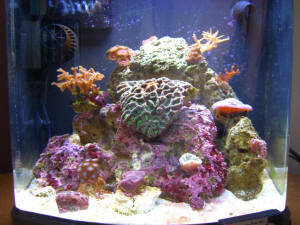 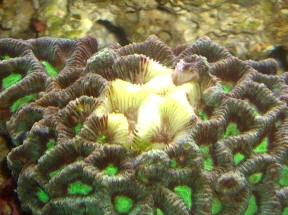 |
Re: 10/02/10 Sick coral
2/11/10
<Hi Nick>
Thanks. No new livestock additions to the tank since this
coral was added. I do run Chemi-Pure Elite at all times as
well as Purigen. I have a small fuge in the back with Chaeto
which is growing like mad.
<This all sounds good>
The only significant change I have made recently is in FLOW.
I've added a Koralia Nano which is not pointing at the
coral, but toward the front of the tank. (see picture - yes,
I know about the Cyano and it is actually better as I've
cut back on feedings). I do know the Koralias do flow out
from the sides of the unit as well... The return from the
sump is also pointed toward the front glass of the tank, and
is on the opposite corner from the Koralia. I change 10 % of
the water twice each week. Could the flow be the problem?
<Only if it is directly on the coral, but the Koralias are
pretty good at negating these effects>
Should I move the Favites lower on the front rock to get it
farther away from the Koralia?
<If you think direct flow is a problem, yes>
The denizens of the tank currently are:
Two Montipora (different species)
Two Birdsnest
One Candycane Caulerpa
One small Oxypora frag (bottom right)
The purple fleshy coral mid-right was sold to me as a
Moseleya, though it doesn't look like it to me
A frag of a Dragon Favia (middle - front) which has turned
all purple, but is eating well (I will be upgrading my
lighting very soon)
Christmas Favia frag
A cluster of Blue Zoas at the bottom
A group of watermelon Palys at the top
<This is a Corallimorph?>
A head of an Acan lord at the very bottom left (this coral,
my very first, had been doing superbly for the past 3 months,
but over the past few days has suffered significant tissue
recession on one side, so I moved it farther away from the
Christmas Favia, which used to send out long sweepers)
A coral I do not know the name of (middle left, next to the
Koralia), which looks to me like a blunt-tipped Birdsnest
<Mmmm, you have a lot of different corals in here of
different types, especially for such a small volume. I have
less species than this in my system which is about 60 times
the water volume of yours. You will do better if you can
choose two or three species that you like, as similar to each
other as you can, and try to grow them larger>
A small fish (a Dottyback)
A few snails
Thanks again for your help,
<No problem Nick>
Nick
<Simon> |
|
Re: 10/02/10 Sick coral, Faviid
-- 02/14/10
<Hi Nick>
Thanks again - perhaps others can learn from my
mistakes.
<Some will, but these (putting many different animals in
a small water volume) are the most common mistakes
made>
Before receiving your response, I blew all of the dead
tissue off with the baster and the all of the pumps and
powerheads running - sounds stupid, yes, but my rationale
was that the chunks of tissue would end up in the sump and
I would just throw away the filter floss.
<Mmm, but this material is toxic...>
I was partly correct, though your way is obviously
better.
<Yes, but this is best done outside the aquarium>
I did not remove the coral to dip it, thinking to limit
stress on it.
<I would have dipped this as soon as I saw tissue
recession>
I did check my water parameters and they were all OK (0
Ammonia, Nitrite, Nitrate; pH 8.2; Alk 3.0meq/l; Ca: 440;
Phosphate undetectable; Mg 1260.) I then did a 15% water
change, changed the ChemiPure and Purigen, cleaned the
sump, and dosed a little iodide.
<Mmm, ok>
This morning the Favites and the Acan look a bit worse
overall, and both refuse to eat.
<I would remove this Favites now into another system if
you can, separate it from the others>
All of my other corals look good and the LPS eat Mysis like
it's going out of style. There is more Cyano today on
the sand (I had siphoned it all off yesterday).
<There is something amiss here..>
There are white spots on the border of many of the Favites
mouths - I noticed them a few days ago and thought they
might be feeding tentacles but they do not extend at all -
could they be a parasite? (see pic).
<No, not likely. More likely they are part of the coral
as you say>
My plan today was to dip the Favites and Acan in Tropic
Marin iodine dip and do another partial water change. What
do you think?
<I would go this route, maybe with separating these to
another system, and look to removing this/ these on a
permanent basis. I think your root cause here is too many
different organisms>
Nick
<Simon>
|
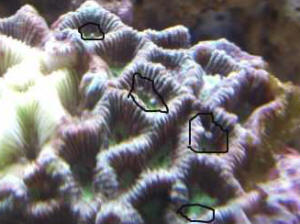 |
Re: 10/02/10 Sick coral
2/24/10
Simon,
<Nick>
A quick follow-up and then a few questions: my tank is located
where I work, so after a long weekend I came back to find the
entire Favites dead - brown, smelly, much of the tissue receded
to visible skeleton. Horrible.
<Mmm, so you did not remove this as directed? Risky.>
Amazingly (especially considering the size of the tank (6 gal))
all other corals, and the fish, had survived.
<Amazing indeed, but I doubt they are thanking you for
it!>
Two of the three SPS were showing tissue recession from the base
up, so I thought they were goners. <Oh dear> I did a larger
than usual water change, fed only the fish for a week, and
everyone is looking good/better. The tissue loss of the Birdsnest
and Pocillopora has also stopped extending.
<That's a good sign at least. These would have gone in a
day had it been too bad>
Here is the question and the advice I need. I bought a Pinpoint
pH monitor, calibrated it and installed it yesterday.
<Mmm, not a fan of these...>
The pH in the tank was only 7.95! <You are actually ok here,
especially for such a small system>. Previously I was using
the colorimetric tests from API and Seachem, and I thought my pH
was in the 8.1-8.3 range (so hard to tell for sure with those
tests...). Did my usual 10% water change, and left the probe in
overnight, and the pH this morning was the same (I run a fuge
with reverse lighting). So I tested the source water, which I buy
premixed from the LFS - they state it's RO and that they use
Tropic Marin salt, and it's a reputable store so I believe
them. Well, lo and behold, the pH of the water I use to make my
water changes with is 8.00!
<Good, and fine>
So here is my question: should I add buffer to the water I use
for water changes before adding it to the tank to raise the pH to
8.3-8.4?
<What is your alkalinity? Never add 'buffer' unless
you know your alkalinity.>
If so, what should I use? I change 10% of the water twice a week,
and I dose Kent's CB to keep Alk. in 3-4 range (it rarely
gets above 3.5 even with dosing) and to keep Calcium in the
440-460 range (I have massive coralline growth all over the tank
:).
<Ahh, ok.. no I would not add anything here... it sounds as if
things are balanced and adding things to get to a 'magic
number' when everything else looks ok can do more harm than
good. The real clue is the animals themselves, and I am not a fan
of pH monitors. In my experience they can be inaccurate and need
calibrating constantly. What is your Mg?>
Or should I dose Kalk? ( I really would prefer not to since I
cannot set up drips at work and would actually prefer not to dose
anything daily). Or something else (I also own Salifert's
all-in-one but stopped using it because my alkalinity was staying
at 3)? What do you suggest?
<Nothing. Just monitor. 7.9 - 8.0 is fine here, really.
Especially since your colorimetric tests are reading higher than
this>
One other question-whenever I feed anything I have enriched with
Selcon (frozen Mysis or newly-hatched brine shrimp, for example),
I am guaranteed to have a nice new carpet of Cyano all over the
sand the next day. Is the HUFA supplementation that
important?
<This is definitely beneficial, and should not be a source for
Cyano, unless you are literally pouring the stuff in. Look
elsewhere for the answer to this problem>
I'm inclined to just feed the LPS's the occasional plain
frozen Mysis (shaken, not stirred), and a tiny bit of live
Roti-feast for the SPSs a couple of times per week in addition to
the fish poop they get (the Dottyback gets a few flakes each
day). Sound reasonable?
<Mmm, check here:
http://www.wetwebmedia.com/corlfdgfaqs.htm>
Thanks again for all of your help.
<No problem>
Nick
<Simon>
|
Favia-Bleaching-Lighting? -03/28/08 I recently got
a Favia specimen. It is about the size of my fist, and is for the most
part a powder blue. It has long brown splotches around the ridges, but
I am sure that this is the natural coloring. Though especially around
the top and not around the sides of the coral it is beginning to become
pale around the ridges, but not in the mouths. They are still very
brilliant. I think that lighting is the issue. Is it possible for a
Favia to have to<o> much light? <Yes and no. They can acclimate to just
about any level of lighting (even intense lighting). However, this
takes time. It sounds like the coral is starting to bleach in response
to a sudden change in lighting.> How much is good. The coral was
about a 10 inches form the surface where there are two VHO bulbs. One
is actinic and the other is 50/50. <What was it under previously,
when you purchased it?> I recently moved it to the sandbed, which is
about 18 inches from the surface. Was this right? What should I do? Are
there anymore details I should include? <Again, if it's a
lighting issue, it's an issue of *change* in lighting. You should
find out what kind of lighting the coral was under previously, then try
and place the coral under similar lighting before slowing moving it to
where you want it. If it continues to bleach, be sure to feed it well.
Bleaching is not a death sentence. Corals "often" bleach out,
then recover. Please see here for some additional info on Faviid
health: http://www.wetwebmedia.com/faviiddisfaqs.htm Best, Sara
M.>
Trumpet Coral... env. hlth... need useful
data 11/26/07 OK. I think I've made a mistake, but
want to check and see whether it's salvageable. I've got a
trumpet coral I've had for a few years. I had a tank leak and did
an emergency switch to a larger tank. When I moved everything, I
figured this was a good time to upgrade a lot of stuff and bought a
MUCH better light (outer orbit T5HO). <Mmm, what sort and from what
previously?> Initially, everything responded well to increased
light. This was in part, I think, due to the fact that there was a film
on top the water until I finally got the sump/overflow set up. I've
never seen the trumpet coral look so good. NOW, however, the trumpet
coral looks like it might be burned. I have two pieces. One up higher,
and one in the middle of the rock wall. The one at the top has a red
mark or two on it and is behaving strangely (tentacles out in the
middle of the day kind of strange) but never fully opening to what it
can be. The one in the middle has gone white almost. Not dead and still
looking fine at night, but white. I've moved them both to the
bottom of the tank after reading a few things on your forums (which
have saved me more times than I can count). I'm wondering whether
that's enough and what steps I should take if any that I
haven't already. At least I know now that start the corals arriving
this week at the bottom till they adjust to the light ;) <Mmm...
could you send along some close up images? And list your other life,
particularly photosynthetic sessile invert.s... Bob Fenner>
Re: BTA & Candy Cane Coral Concerns - 09/14/07 <Hello
again Jackie.> Thanks for the valued information. <You're
welcome.> Sorry to hear about your Cleaner Shrimp. <Thanks. Was
quite a while ago now.> I have another question regarding the Candy
Cane coral. <OK.> Do they, throughout the course of a day, change
from soft to rock hard? <They can change, though rock hard is
generally not happy.> Or is that a sign that all is not well?
<Prolonged periods of rock hard is not a good sign... consult a
doctor if lasting 4 hours or more... oh wait... that's something
else... heehee!> Also, how important is Strontium for LPS corals?
<If you do regular water changes you should be fine. You may want to
check your calcium levels.> Again, thanks for all the good advise
your team provides. <On behalf of Bob and the crew, you're
welcome! Mich> Jackie
|
|

